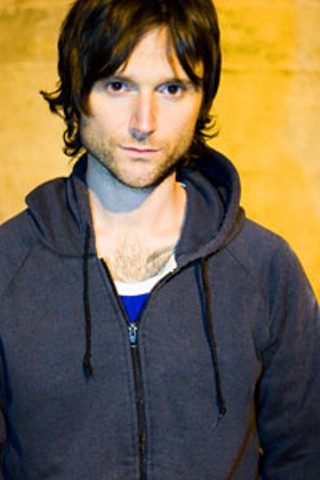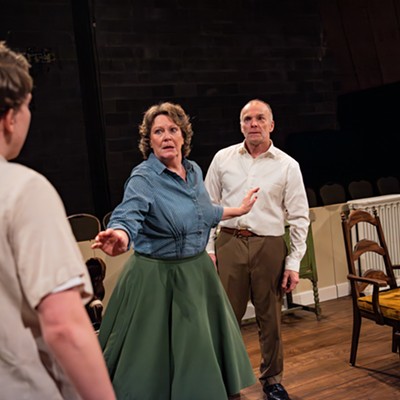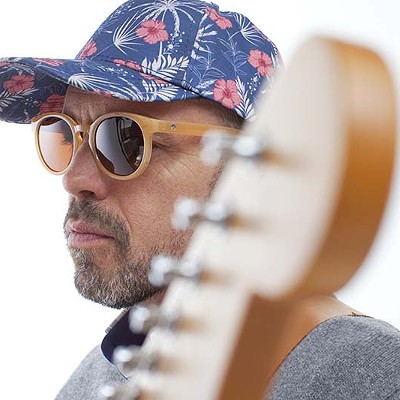In 1988 a teenaged boy from Dartmouth named George Stamos won the MT&T award for choreography. It’s all been uphill from there. Not necessarily for the Maritime Telegraph and Telephone company (which merged to form Aliant in 1999), but for Stamos, who has since performed throughout Europe, US and Canada, working as both a dancer and a choreographer.
Stamos’s recent work has been described as “salacious,” “busy and gritty,” “surprisingly smooth,” “buzzed up on internal energy,” “drips with sex,” “contorted but fluid,” “beauty transcends,” “sinuous rolling,” “physically demanding,” “nostalgic” and “high-heeled.” Returning to his hometown for a week from now-home Montreal, Stamos will perform two of the works that inspired the above descriptors, Schatje and Reservoir, at the Sir James Dunn Theatre from October 12 to 14.
Dutch for “sweetie,” Schatje is informed by Stamos’s work as a go-go dancer at clubs in New York, Amsterdam, London, Toronto and Montreal. It explores the relationship between seduction and violence, and employs a battalion of stimuli, including stilettos, briefs, video projection and a live DJ.
Reservoir is decidedly softer and more intimate in tone, and replaces Schatje’s tight white undershirts with layers of pastel sweaters. Stamos’ newest work, Reservoir was created this June to plumb the depths of our personal reservoirs of strength in times of crisis.
Calling on a busy afternoon in montreal, Stamos has been rushing to finish his press packages in time for an October tour that sees him carving a skinny, horizontal V across the country from Edmonton to Halifax and back to Calgary.
“Dance is an art form that always made a lot of sense to me,” says Stamos. “But to it has really changed—as I’ve grown up, I’ve gotten a more mature relationship to it.”
Business is an important side of this grown-up relationship, and Stamos, who operates as a self-employed individual and not a dance company, dedicates much of his time to administrative work. “A lot of people in my generation are in this situation where we’re not companies, but we’re acting kind of like companies,” says Stamos. “It’s really, I’m freelance. And to have a career I dance for other people and I do my own work as well. I need between two and four good projects a year.”
Following his tour of Schatje and Reservoir, Stamos is off to San Francisco in November to work with choreographer and long-time collaborative partner Sara Shelton Mann. He is also working with Isabelle Van Grimde of Montreal, and will tour Germany and France in the spring. “I feel like I’m in a really good place because I have some connections with certain choreographers where we have a really good, mature relationship, where we can collaborate and they’re committed to bringing me back into their projects,” says Stamos.
Locally, Stamos credits the late Diane Moore—“this incredible woman”—of Live Art Dance Productions, which is presenting his show, for introducing him to Shelton Mann, and bringing him home to Halifax to perform throughout the ’90s.
In 1993, after graduating from The School for New Dance in Amsterdam, Stamos moved to New York City and started working as a go-go dancer. One of his biggest influences at the time was a former New Dance instructor, the late Willy Ninja. “He was an amazing, amazing performer,” says Stamos. “He basically brought Vogue to Madonna; he choreographed that video, most of the dancers. That artform comes from New York and the ’70s and ’80s and he’s part of the roots of that.”
As a go-go dancer, it was Stamos’s job to “inspire the atmosphere of the room,” and “stimulate the room to be more fun,” while struggling to maintain focus and keep up his energy for hours of intense cardio.
“Some of the hardest work I’ve done has been as a go-go dancer,” says Stamos. “You’re incredibly exposed, like, not what you’re wearing (although it’s not much), but just your proximity to the people that you’re performing for. It’s an immediate connection, and it’s a real challenge to maintain your energy and your focus and the attention in that kind of context where people are partying and there’s this kind of loose atmosphere going on.
“A lot of people in the modern dance world, they like the way go-go dance sounds, like a kind of catch phrase, but I don’t think they understand how hard it is to do that work, and the art form that’s there.”
Years of working as a go-go dancer has enriched Stamos’s reservoir of creative choices when it comes to creating his own work. This influence is especially evident in pieces like Schatje, which explores ideas of sexuality and gender.
“The intensity of the performance and the focus and the directness is something that can very easily be transmitted into work on the stage that you can see in a body state, an attitude, a comfort with your own sexuality,” says Stamos. “We do have sexual readings on the way we move, and that’s part of the choice of a dancer that you have at your palette to play with. In the modern dance world, people don’t talk about this usually—you know, guys are guys and girls are girls and ‘can we have two guys in two suits and two girls in two Lycra dresses please?’”
Schatje toys with traditional expectations of masculinity and femininity, and questions the differences—behavioural, not anatomical—between men and women. It also delves into the politics of flirting and investigates “what happens between people and how people negotiate those sorts of situations.” Schatje’s tension is heightened by the nightclub setting, where the “very plastic and kind of throw-away pop culture element to the environment,” is at direct odds with “these really fragile human things, like how people feel about themselves.”
“With Schatje there’s a look at the surface, the glossy pop surface, and then there’s also a look at what’s underneath that, which is maybe not as pretty,” says Stamos. “Often there’s this dynamic in life where if you have something that’s sort of disturbing there’s this tendency in our culture to put a glossed-over picture over it. Schatje is operating in that world.”
Reservoir, on the other hand, is “over all that.”
“I definitely think it’s a more mature piece, in terms of the psychology of it,” says Stamos. “A lot of the questions raised in Schatje are more, perhaps, adolescent, although they still permeate your life.”
Reservoir takes its title from the hidden reservoirs within each of us that we call on to get ourselves through difficult times. “We all have to deal with stress, we all have to deal with problems, so what’s our reservoir of strength?” asks Stamos. “What do we pull on?
“When you asked yourself that, ‘what are our reservoirs,’ they’re huge. It’s amazing, especially when you see people dealing with traumatic situations, the reservoirs that kick in. Like the classic story about the mother who lifts the car to save her child. There’s this incredible reservoir that’s sitting there, whether it be on a chemical level—a certain amount of adrenaline that’s reserved for 30 seconds—or whether it’s psychological. It’s all that. Energetically I’m trying to taste that…to turn the valve up a little bit....”
So what is it about dance that makes it such a powerful medium of expression?
“I don’t think dance always is so powerful,” laughs Stamos, “but I think dance can be a very powerful medium because there are things that can be transmitted through dance and performance that cannot be transmitted any other way. We can talk about it, write about it, paint it, video it, but the live performance and what happens with the live performance, it’s the only context that that can be transmitted in. I see it as a really unique art form.
“What I’m impressed with when I see dance that I like, is how it’s able to cover the psychological, spiritual, physical, all different levels can be transmitted. And I find that really satisfying. That way you can receive, as an audience, something that you feel inside your body, you have an idea about it. Plus there’s an aesthetic going on too. It’s very exciting. It’s really hard to get it, but that’s what my focus is on. To work all the different levels that are there."
George Stamos w/Clara Furey, Luciane Pinto, Sarah Williams, David Madden and Owen Chapman, October 12-14, Sir James Dunn Theatre, 6101 University, 8pm, $15-$22, 494-3820.















